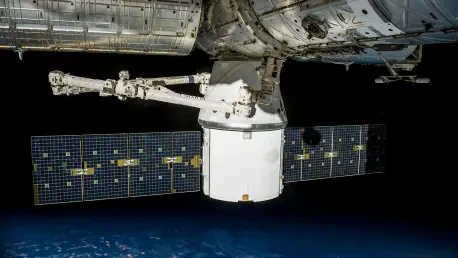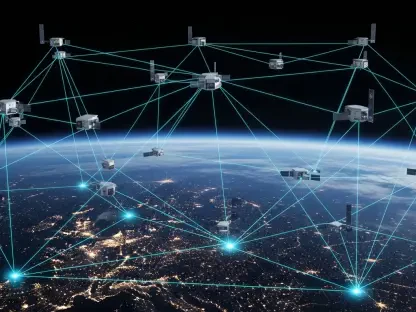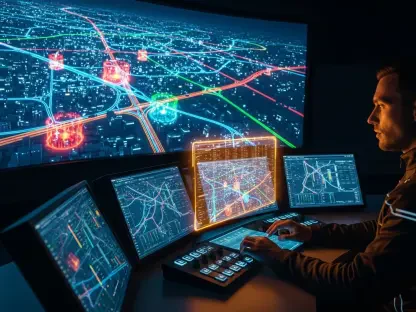In a startling revelation amid the ongoing conflict in Ukraine, the presence of Chinese reconnaissance satellites orbiting above the region during a Russian missile and drone attack on October 5 has sparked intense scrutiny and concern among global observers. Specifically, at least three satellites from the Yaogan 33 series, along with the Yaogan 34, were tracked over the Lviv region in western Ukraine, raising critical questions about their purpose and the potential military ramifications of their presence. Public data from monitoring platforms such as Heavens-Above and n2yo provided a rare window into these space-based activities, coinciding with active hostilities on the ground. This development not only highlights the sophisticated capabilities of modern satellite technology but also casts a spotlight on the murky intersection of geopolitics and space operations, where the line between civilian and military intent often blurs. As tensions escalate, the role of these satellites in the conflict remains a pressing issue for Ukraine and its international allies, prompting deeper investigation into their strategic significance.
Satellite Observations and Operations
Tracking Movements Above Lviv Region
On October 5, a meticulous tracking effort revealed the precise movements of several Chinese satellites over western Ukraine during a Russian strike, painting a picture of deliberate and frequent observation. The Yaogan 33 series, including Yaogan 33, Yaogan 33-03, and Yaogan 33-04, completed nine passes over the Lviv region between midnight and 11:30 a.m., while the Yaogan 34 entered the airspace around 6 a.m., with plans for multiple orbits that day. Positioned in low Earth orbit at approximately 700 kilometers altitude, these satellites circle the planet every 90 minutes, allowing for repeated and detailed scans of specific areas. Such orbital patterns suggest a capability to monitor events in near real-time, raising concerns about the nature of data being collected during these passes. While the exact activities of the satellites remain unconfirmed, their presence during a military operation underscores the potential for space-based assets to influence terrestrial conflicts, especially in a region as volatile as Ukraine.
The significance of these observations extends beyond mere coincidence, as the frequency and timing of the satellite passes align closely with the Russian attack, fueling speculation about their strategic purpose. With over 60 Yaogan-series satellites reportedly having orbital paths that cover Ukraine, the scale of China’s space network becomes evident, offering a robust platform for sustained monitoring. Data from public tracking services not only confirms the satellites’ positions but also highlights how accessible such information has become, enabling analysts and policymakers to piece together patterns of behavior in space. This transparency, however, contrasts sharply with the opacity surrounding the satellites’ true objectives, leaving room for debate over whether their presence indicates active reconnaissance or merely routine operations. For Ukraine, the implications are profound, as even the possibility of foreign satellite data aiding hostile actions demands heightened vigilance and international dialogue to address potential threats emanating from above.
Orbital Patterns and Strategic Timing
Delving deeper into the orbital mechanics, the Yaogan satellites’ low Earth orbit positioning facilitates a high revisit rate over specific regions like Ukraine, amplifying their potential for detailed observation. Operating at an altitude of around 700 kilometers, these satellites can capture imagery or signals multiple times a day over the same area, a feature that proves invaluable for monitoring dynamic situations such as military engagements. On the day of the Russian strike, the concentrated passes over the Lviv region suggest a targeted focus, though whether this was coincidental or intentional remains a matter of speculation. The ability to maintain such consistent coverage underscores the technological sophistication of China’s space program and its capacity to project influence far beyond national borders. For nations embroiled in conflict, this persistent overhead presence poses a unique challenge, as distinguishing between benign and hostile intent in space activities becomes increasingly complex.
Moreover, the strategic timing of these satellite orbits during active hostilities amplifies concerns about their role in the broader geopolitical landscape. While no definitive evidence confirms data collection during the specific incident on October 5, the alignment with Russian military actions raises questions about possible coordination or intelligence sharing. The fact that these satellites belong to a series widely suspected of dual-use capabilities—balancing civilian and military functions—further complicates the narrative. For Ukraine and its allies, this situation highlights the urgent need for enhanced space situational awareness and international frameworks to govern the use of satellites in conflict zones. As space becomes a contested domain, the intersection of technology and warfare demands careful scrutiny to prevent escalation driven by unseen forces orbiting high above the battlefield, shaping outcomes in ways that are difficult to predict or counter.
Technical Capabilities and Geopolitical Implications
Advanced Features of Yaogan Technology
The Yaogan series, particularly the newer models launched in recent years, represents a significant leap in satellite technology, with capabilities that rival some of the most advanced systems globally. Equipped with synthetic aperture radar (SAR), these satellites can produce high-resolution images regardless of weather conditions or time of day, penetrating cloud cover and darkness to reveal detailed ground activity. Compared to older models like Yaogan-1, which boasted resolutions of 5 meters over narrow swaths, the current iterations are believed to offer even sharper imaging, reflecting over a decade of technological progress. Although China publicly states that these satellites serve civilian purposes such as land resource surveys and disaster prevention, the potential for military applications cannot be overlooked. This duality fuels skepticism among analysts who argue that such advanced tools could easily support reconnaissance efforts in conflict zones like Ukraine.
Beyond imaging, the Yaogan satellites likely incorporate additional features, such as electronic signal interception, enhancing their utility for comprehensive intelligence gathering. The ability to operate in low Earth orbit ensures frequent passes over target areas, providing near-continuous data streams that could inform tactical decisions if used for military purposes. While no concrete evidence confirms active reconnaissance during the October 5 incident, the mere presence of these technologically advanced assets during a Russian strike raises red flags. For nations monitoring the conflict, this underscores the challenge of distinguishing between peaceful scientific missions and covert military support, especially when the technology in question holds such versatile potential. As space-based capabilities continue to evolve, the international community faces growing pressure to establish clearer norms and transparency measures to address the risks posed by dual-use systems in sensitive geopolitical contexts.
Evidence of Russian-Chinese Collaboration
Reports from Ukrainian and U.S. intelligence sources have pointed to a troubling pattern of cooperation between Russia and China, particularly in the realm of satellite-derived intelligence sharing. It is alleged that China has provided Russia with data that may have been used to facilitate military strikes on Ukrainian targets, including critical infrastructure. While specific details about the targeted locations remain undisclosed, the broader implications of such assistance are significant, suggesting a strategic alignment that could alter the dynamics of the conflict. Historical transactions, such as a deal in 2022 where a company linked to the Wagner Group acquired high-resolution surveillance satellites from a Chinese firm, further illustrate the depth of this partnership. These arrangements often include access to on-demand imagery, amplifying Russia’s ability to conduct precise operations across multiple theaters, including Ukraine.
This collaboration extends beyond mere commercial deals, reflecting a broader geopolitical alignment that raises alarms among NATO and other Western entities. The provision of satellite data, if confirmed, represents a form of indirect support for Russia’s military objectives, potentially undermining international efforts to de-escalate the conflict. The use of space-based assets in this manner also highlights the evolving nature of warfare, where information dominance can be as critical as traditional firepower. For Ukraine, the knowledge that foreign satellite intelligence might be aiding hostile forces adds a layer of complexity to an already challenging situation, necessitating robust countermeasures and diplomatic efforts to address this unseen dimension of the war. As evidence of Russian-Chinese ties in space operations accumulates, the need for a coordinated international response becomes increasingly apparent to mitigate the risks of such alliances reshaping global security landscapes.
Broader Strategic Concerns in Space
The recurring presence of Chinese satellites over conflict zones during active hostilities signals a potential shift in how space is leveraged for strategic purposes, prompting concern among Ukraine’s allies. Even if active data collection during specific passes remains unverified, the pattern of orbits coinciding with military actions suggests an intent that goes beyond routine scientific missions. This situation amplifies fears that space is becoming a new frontier for indirect involvement in terrestrial conflicts, where nations can influence outcomes without direct engagement. For NATO and other stakeholders, the challenge lies in countering these subtle yet impactful interventions, especially when they involve powerful states with advanced technological capabilities. The ambiguity surrounding the true purpose of these satellites only heightens the urgency for clearer international guidelines on space activities during wartime.
Furthermore, the growing Russian-Chinese alliance in space intelligence underscores a broader geopolitical trend that could reshape global power dynamics. The sharing of satellite data, combined with commercial and strategic partnerships, points to a coordinated effort to challenge existing international norms, potentially destabilizing regions already grappling with conflict. For smaller nations like Ukraine, this creates an uneven playing field, where adversaries gain advantages through unseen assets high above the Earth. Addressing these concerns requires not only technological innovation to monitor and counter space-based threats but also diplomatic initiatives to foster transparency and accountability in space operations. As the line between civilian and military use of satellites continues to blur, the international community must prioritize mechanisms to prevent space from becoming a silent battleground that exacerbates conflicts on the ground.









